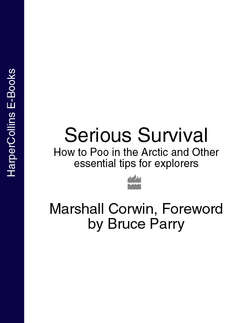Читать книгу Serious Survival: How to Poo in the Arctic and Other essential tips for explorers - Bruce Parry - Страница 19
ОглавлениеFood and Water
Carting bulky food and gallons of water on expedition is always a non-starter, and in the Arctic it’s particularly pointless as everything would quickly be frozen solid. So apart from a few treats, freeze-dried expedition rations, pasta and porridge are probably the answer. You just need to add water. This raises the obvious question – where does the water come from? The answer of course is the endless supply of snow.
MELTING SNOW
This is one of the most essential – and tedious – jobs on an Arctic expedition, easily taking two or three hours every day.
First you need to fill a bin-liner with chunks of fairly solid, compressed snow (don’t take powdery stuff from the surface). The old cliché ‘don’t eat yellow snow’ applies, so camp discipline in having well-defined pee and poo spots really pays off.
Then it’s simply a case of stuffing endless small amounts of the snow into a saucepan, prodding and stirring constantly. Put a little water in first, otherwise much of the snow will be lost as steam and the pan will burn.
Snow is full of air, and depending on how densely the original snow is packed together, you will get at best about one-third as much water (it might even be as little as one-tenth). The water produced will be all you have for drinking and cooking. After so much effort you probably won’t want to ‘waste’ any for cleaning and washing – small chunks of snow will do fine for this.
THE ARCTIC DESERT
It’s one of those strange facts about the Arctic that it’s actually a desert. In the Arctic, rainfall and snowfall combined comes to less than 25cm (10in) of water. This qualifies it as a desert region, though scientists make the distinction between hot and cold deserts.
It also feels incredibly dry; cold air has hardly any moisture in it. This means that as you breathe you feel very parched.
In these conditions dehydration is a serious problem. It’s hard to force yourself to keep drinking when it’s so cold and can be such an effort to get liquid, but you’ll need at least 5 litres (1 gallon) a day to cope with all the exertion of an expedition.
HOW DO YOU take something with you to drink? Won’t it just freeze?
This is a rather crucial question that may not even cross your mind unless you’ve been to the Arctic. The fact is that in temperatures way below zero just about all liquids freeze (even mercury used in thermometers freezes at around –39°C/–38°F).
So this is where a rugged vacuum flask comes into its own. It will keep water cold all day without freezing, though on an Arctic expedition it’s best to put a hot drink in it to help keep you warm.
DRINK YOUR HOT WATER BOTTLE!
One trick for avoiding dehydration is to drink the water in your hot water bottle. When you go to bed it’s great to have a sturdy plastic bottle filled with hot water to keep your feet warm. By morning it’ll be pretty cold, and instead of wasting the precious water force yourself to drink it all. You’ll already be getting dehydrated after a night breathing dry, cold air, and it’ll get the day off on the right foot (no pun intended).
THE ARCTIC DIET
Most polar explorers come back far lighter than they started, a result of the huge effort involved in most activities, plus the energy used in keeping warm. A male adventurer may use up more than five thousand calories a day in the Arctic, double what he needs on a typical day back in ‘civilisation’. To stay the same weight he would have to eat the equivalent of about eighty slices of bread each day.
So you need to eat a lot, and in particular a lot of carbohydrates for energy – a great excuse to eat plenty of chocolate and sugar (though a frozen bar of chocolate will need to be warmed in an inside pocket before you can bite into it). While most expedition food will inevitably be stuff you add water to, take along a little ‘real’ food to thaw out for special occasions. It’s amazing what a bit of bacon, sausage or salami can do for morale.
